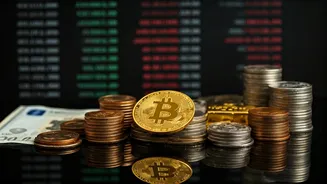Gold's Diminishing Shine
For years, gold has been a favored asset, valued for its perceived safety and stability, particularly during times of economic uncertainty. However, the
investment world is always changing. Several factors are causing investors to reconsider their commitment to physical gold. The primary reason for this shift is the opportunity cost associated with holding gold. Unlike assets that generate income, such as stocks or bonds, gold does not produce any dividends or interest. Investors only realize a return when they sell it at a higher price than what they paid for it. This can be problematic in times of low inflation and interest rates, as it makes gold less competitive compared to income-generating assets. Furthermore, the price of gold is affected by global economic factors, including inflation rates, currency fluctuations, and geopolitical events. High inflation can drive up gold prices, while a strong US dollar can make gold more expensive for investors using other currencies. Investors are becoming more aware of these risks, prompting them to explore other investment options.
Factors Behind the Shift
Several catalysts are influencing investors' decisions to move away from physical gold. The first is the rise of alternative investment options. The stock market, although volatile, has, in the long run, provided significantly higher returns than gold. The returns from bonds have also been attractive. The advent of Exchange-Traded Funds (ETFs) has made it easier than ever to invest in a broad range of assets, including stocks, bonds, and real estate, reducing the need to hold physical gold as a means of diversification. The other key driver behind this shift is the evolving understanding of economic indicators. While gold is still seen as a hedge against inflation, other assets like inflation-protected bonds may provide more direct protection against rising prices. Investors are increasingly sophisticated and more willing to adapt their investment strategies. Furthermore, changing attitudes towards risk have also played a role. Many investors now feel comfortable with the risk associated with other assets, which diminishes the need for the perceived safety of gold. These elements collectively shape a new investment paradigm.
Alternatives Emerging
With gold's luster fading, numerous other investment options are stepping in to fill the void. Stocks are a popular choice. Historically, the stock market has offered higher returns than gold over the long term, although it does come with more risk. Investing in a diversified portfolio of stocks through mutual funds or ETFs helps mitigate some of the risks. Bonds also continue to be a stable choice for investors seeking income and relative safety. Government bonds, in particular, are considered low-risk assets. Real estate is another option that appeals to investors looking for tangible assets. Investing in real estate can provide rental income and capital appreciation over time, making it an attractive option for those looking to diversify. Digital assets, particularly cryptocurrencies, have also gained popularity. The price swings in crypto can be very dramatic. As a result, cryptocurrencies should be approached with caution. Every choice presents its own unique combination of potential rewards and inherent risks, thereby encouraging investors to choose wisely.
Investor Strategies Evolve
As investors navigate the changing landscape, new strategies are emerging. Diversification remains key. Diversifying across different asset classes reduces the overall risk of a portfolio. Rebalancing a portfolio periodically to maintain the desired asset allocation ensures that investments remain aligned with an investor's risk tolerance and financial goals. Also, many investors are starting to conduct deeper research, evaluating the fundamental strengths of companies or the overall economic conditions that might affect their investments. Some investors are seeking professional financial advice to help them navigate complex markets and make informed decisions. Financial advisors can help create personalized investment plans tailored to individual needs and goals, taking into account factors like risk tolerance, investment horizon, and financial objectives. This trend highlights a more informed and adaptable approach to investing, suggesting a future where portfolios are as dynamic as the markets themselves.
The Future of Gold
The decline in gold's popularity does not necessarily mean the end of its investment value. Gold will likely continue to play a role in investment portfolios for certain investors, especially those seeking a hedge against extreme economic scenarios. However, it will probably no longer hold the dominant position it once did. The price of gold will continue to be driven by multiple factors. Changes in interest rates, inflation, and currency values will likely remain significant. Investors must consider these elements and adapt their strategies to stay ahead of the curve. The role of gold in investment portfolios is also evolving. It's likely to be incorporated alongside other asset classes rather than being considered a standalone, primary investment. This integrated approach reflects the greater diversity of investment products in the modern era, creating a more comprehensive approach to wealth management and market participation.











